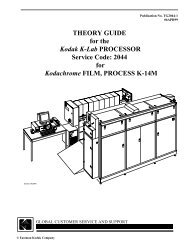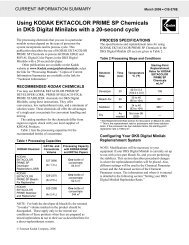2 chemicals and chemical mixing - 125px
2 chemicals and chemical mixing - 125px
2 chemicals and chemical mixing - 125px
Create successful ePaper yourself
Turn your PDF publications into a flip-book with our unique Google optimized e-Paper software.
Table 2-1<br />
Processing Capacity of Process E-6AR Chemicals<br />
Process E-6AR<br />
Chemical<br />
Mix<br />
Volume<br />
(gallons)<br />
Replenishment<br />
Rate<br />
(mL/sq ft)<br />
Amount<br />
of Film<br />
Processed per<br />
Cube<br />
(sq ft)<br />
First Developer 25 200 475<br />
Reversal Bath 100 100 3,780<br />
Color Developer 25 200 475<br />
Pre-Bleach 50 100 1,890<br />
Bleach 5 20 950<br />
Fixer 50 100 1,890<br />
Final Rinse 320 100 12,110<br />
CHEMICAL MIXING<br />
Procedures<br />
The liquid concentrates supplied by Kodak make it easy to<br />
prepare processing solutions for Process E-6. However, to<br />
avoid errors that can affect process quality <strong>and</strong> control, mix<br />
these solutions carefully according to the instructions<br />
supplied with the <strong><strong>chemical</strong>s</strong>. This section gives you tips to<br />
help you use proper <strong>mixing</strong> procedures.<br />
Prepare all solutions with water between 68 <strong>and</strong> 104°F<br />
(20 <strong>and</strong> 40°C). However, it is best to use water that is close<br />
to your processing temperature to avoid unnecessary delays<br />
waiting for the solution to come to temperature, <strong>and</strong> to avoid<br />
using a replenisher with a temperature that is drastically<br />
different from the temperature of your tank solution.<br />
Note: For consistent results, always use water at the same<br />
temperature when preparing solutions.<br />
For information on diagnosing <strong>mixing</strong> errors, see<br />
section 5, “Corrective Actions for Processing Solutions.”<br />
Water Quality<br />
Water can have a significant effect on photographic quality.<br />
Generally, most municipal water supplies are satisfactory for<br />
<strong>mixing</strong> solutions <strong>and</strong> for use as wash water. Note that the<br />
quality of water supplies can vary seasonally. It is a good<br />
idea to have the quality of your water supply tested. Water<br />
used for washes should have less than 1,000 ppm of total<br />
dissolved solids <strong>and</strong> be free of color, suspended material,<br />
hardness, <strong>and</strong> heavy metals. The pH should be 7.0 to 8.5, <strong>and</strong><br />
the water should not be highly buffered.<br />
The water supplied by most municipalities is satisfactory<br />
for preparing processing solutions. Practical limits for<br />
common water impurities for photographic processing are<br />
listed in Table 2-2. if you use well water, be sure that you test<br />
it for the impurities listed in Table 2-2.<br />
Poor plumbing materials (old, rusty pipes, or pipes made<br />
out of the wrong materials) can be a source of dirt <strong>and</strong><br />
contamination. Check your plumbing <strong>and</strong> replace it if<br />
necessary.<br />
Table 2-2<br />
Practical Limits of Impurities for Water Used in<br />
Photographic Processing<br />
Impurity<br />
Acceptable Limit of Range<br />
(ppm)<br />
Color, suspended material None<br />
Dissolved solids 1,000 (for washes)<br />
250 (for preparing solutions)<br />
pH 7.0 to 8.5<br />
Hardness, as CaCO3 40 (preferable) to 150<br />
Cooper, iron, manganese 0.10 each<br />
Chlorine, as free<br />
hypochlorous acid<br />
2<br />
Chloride 100<br />
Bicarbonate 150<br />
Sulfate 200<br />
Sulfide 0.10<br />
Note: The values in Table 2-2 are from Water Quality<br />
Criteria by West (PSE V.9, pp. 398—413 [1965]).<br />
2-3

















